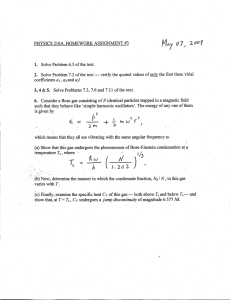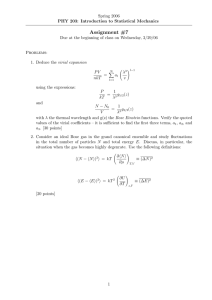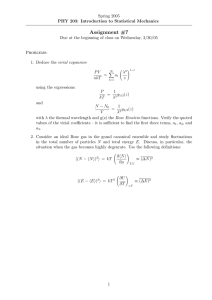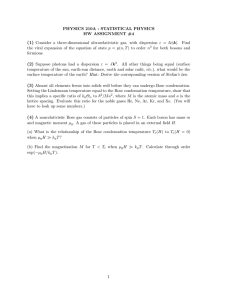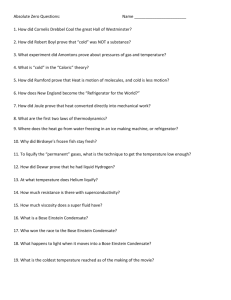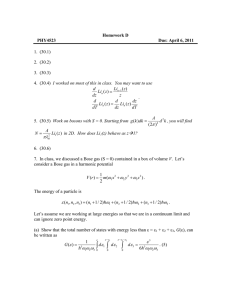8.514: 9/30/03 Bose condensation
advertisement
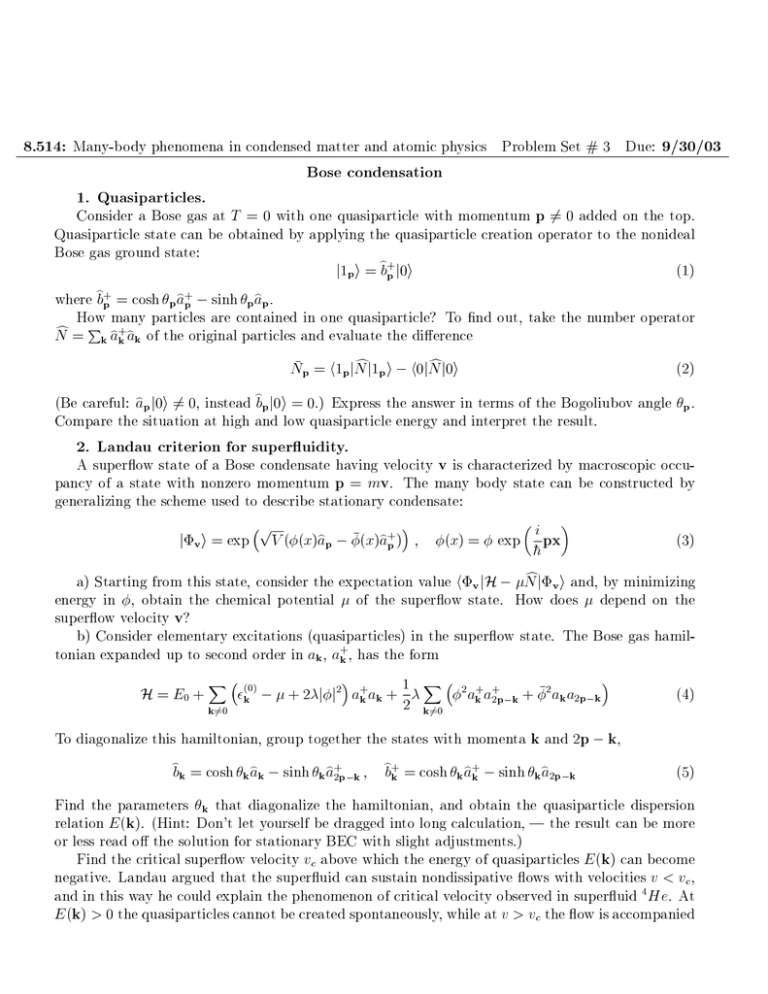
8.514: Many-body phenomena in condensed matter and atomic physics Problem Set # 3 Due: 9/30/03 Bose condensation 1. Quasiparticles. Consider a Bose gas at T = 0 with one quasiparticle with momentum p = 6 0 added on the top. Quasiparticle state can be obtained by applying the quasiparticle creation operator to the nonideal Bose gas ground state: j1pi = bb+p j0i (1) where bb+p = cosh p ab+p ; sinh p abp. How many particles are contained in one quasiparticle? To nd out, take the number operator Nc = Pk ab+k abk of the original particles and evaluate the dierence (2) Np = h1pjNcj1pi ; h0jNcj0i (Be careful: abp j0i 6= 0, instead bbpj0i = 0.) Express the answer in terms of the Bogoliubov angle p . Compare the situation at high and low quasiparticle energy and interpret the result. 2. Landau criterion for superuidity. A superow state of a Bose condensate having velocity v is characterized by macroscopic occupancy of a state with nonzero momentum p = mv. The many body state can be constructed by generalizing the scheme used to describe stationary condensate: p jv i = exp V ((x)abp ; (x)ab+p ) (x) = exp hi px (3) a) Starting from this state, consider the expectation value hv jH ; Ncjv i and, by minimizing energy in , obtain the chemical potential of the superow state. How does depend on the superow velocity v? b) Consider elementary excitations (quasiparticles) in the superow state. The Bose gas hamiltonian expanded up to second order in ak, a+k , has the form X X H = E0 + k(0) ; + 2jj2 a+k ak + 12 2ak+a2+p;k + 2ak a2p;k (4) k�0 6 k6�0 To diagonalize this hamiltonian, group together the states with momenta k and 2p ; k, = cosh k abk ; sinh kab+2p;k bb+k = cosh kab+k ; sinh k ab2p;k (5) Find the parameters k that diagonalize the hamiltonian, and obtain the quasiparticle dispersion relation E (k). (Hint: Don't let yourself be dragged into long calculation, | the result can be more or less read o the solution for stationary BEC with slight adjustments.) Find the critical superow velocity vc above which the energy of quasiparticles E (k) can become negative. Landau argued that the superuid can sustain nondissipative ows with velocities v < vc, and in this way he could explain the phenomenon of critical velocity observed in superuid 4 He. At E (k) > 0 the quasiparticles cannot be created spontaneously, while at v > vc the ow is accompanied bbk by massive quasiparticle creation, and is thus dissipative. Find the critical velocity vc for nonideal Bose gas. c) Can you interprete the result of part b) for quasiparticle dispersion in superow from the point of view of a Galilean transformation? Note that the microscopic hamiltonian is invariant with respect to changing the reference frame from stationary to moving, x0 = x + vt, t0 = t. Show that for an excitation with frequency ! and wavevector k this yields !0 = ! ; kv, k0 = k. How is the quasiparticle energy changed under a Galilean transformation? 3. Condensate depletion. a) In a nonideal Bose gas at T = 0 only a fraction of all the particles is found in the condensate. The reduction of condensate density due to interactions is called \condensate depletion." (An extreme example is prodided by 4 He, where the majority of the particles | more than 90% | are not in the condensate. To estimate this eect in a weakly nonideal Bose gas, nd the expectation value of the total density X nb = nb 0 + V ;1 nb k nb k = ab+k abk (6) k6�0 over the ground state. The rst term gives the condensate density n0 = ha+0 ab0 i, while the second term gives the density of the out-of-condensate particles. Find the depletion factor (n ; n0 )=n dependence on the coupling constant . b) Consider the correlator of the eld operators R(xPx0 ) = h0jb+(x)b(x0 )j0i. Show that it is related to the particle number distribution as R(x ; x0 ) = kh0jnkj0ieik(x;x ). Describe the behavior of R(x ; x0) as a function of point separation x ; x0. Find the limits at jx ; x0j ! 1 and at x = x0 . Estimate the length scale , called BEC healing length, at which the crossover from R(0) to R(1) takes place. 0 4. Thermodynamics of a Bose gas. Thermodynamic quantities of Bose-condensed gas can be found by treating the system as a gas of noninteracting Bogoliubov quasiparticles obeying Bose statistics. The thermodynamic potential of the system is Z ;T ln Z = T ln 1 ; e; E(k) d3 k E (k) = q(0) (k) ((0) (k) + 2n) (2)3 (7) with (0) (k) = h 2k2 =2m. a) Show that simple analytical results for the thermodynamic potential can be obtained at very low temperatures, T T n and at moderately high temperatures, T T TBEC . (Hint: Given the temperature, low or high, simplify the form of E (k) by ignoring (0) (k) compaired to n, or vice versa.) b) Find the entropy, the specic heat, and the normal component density n(T ) in the above two temperature intervals. Compare with the ideal Bose gas.
